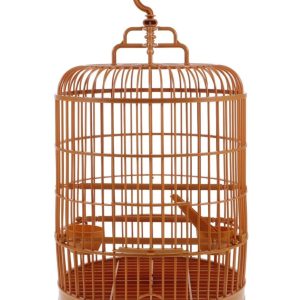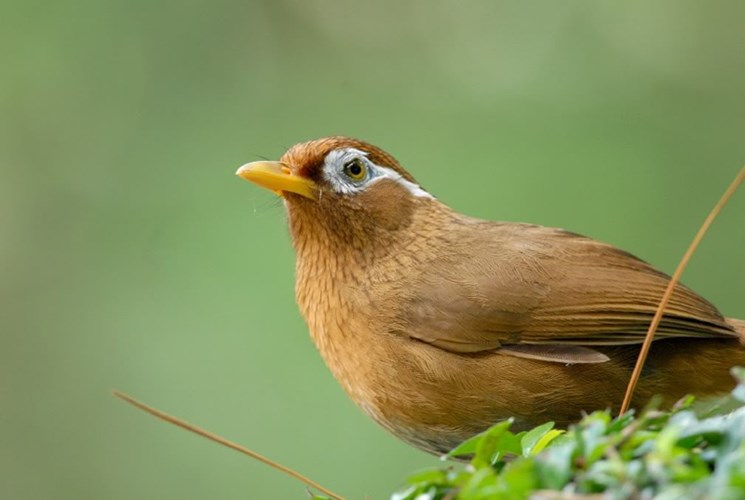News
Oriental Magpie-Robin
The Oriental Magpie Robin is likely one of the most desired pet birds for bird enthusiasts, thanks to its charming appearance and a captivatingly clear, melodious song that captivates listeners. We believe that the following information will help you learn more about this bird, including its characteristics, song, care tips, and pricing.
1. Introduction to the Oriental Magpie Robin
The Oriental Magpie Robin is one of the most commonly kept pet birds, present in most households of bird enthusiasts. Not only does it sing beautifully, but it also has a very cute and appealing appearance. Moreover, keeping a bird that sings well is quite challenging, making these birds a popular choice for those looking to tame and train them.
1.1. What is the Oriental Magpie Robin?
The scientific name of the Oriental Magpie Robin is Garrulax canorus, a species belonging to the Leiothrichidae family. The name “Oriental Magpie Robin” comes from the bright ring around the eyes, which is a distinguishing feature of the bird, meaning “painted on the eyelids.”
Training and taming the Oriental Magpie Robin is quite difficult. For those who love birds, successfully raising a singing, well-trained one is considered a major achievement and reflects their passion and commitment to birdkeeping. According to experienced bird enthusiasts, it may take 2 to 3 years to train a wild-caught bird to sing beautifully.
1.2. Origin and Habitat of the Oriental Magpie Robin
The Oriental Magpie Robin has been around for a long time and still exists in large numbers today. This bird is commonly found in Southeast Asia, particularly in regions such as central and southern China, Laos, and the northern and central parts of the region. They can also be found in natural and man-made forests.
This species prefers habitats such as shrublands, open forests, secondary forests, gardens, and parks, typically at altitudes of more than 1,800 meters above sea level. The ideal environment for these birds is subtropical regions, high-altitude mountains with cooler, temperate climates.
1.3. Appearance of the Oriental Magpie Robin
In addition to its captivating song, the Oriental Magpie Robin has a slender and balanced body. Here are some notable physical features:
- The body is well-proportioned with symmetrical parts; the head is round, the beak is sharp, and the tail is straight and dense. It has long legs with sharp claws.
- The plumage is not particularly colorful or striking but varies in tone depending on the region and climate. In higher altitudes, the feathers are often pale with a silvery tint, while in warmer, lower altitudes, they appear more golden.
- The most notable feature of the bird is its eyes, which are round and bright without any visible whites, giving it a deep and striking look.
1.4. Behavior of the Oriental Magpie Robin
In the wild, the Oriental Magpie Robin is typically solitary. It only pairs up during the breeding season, and after the offspring mature, the parents separate to live independently. This bird is very territorial, especially the males, which are aggressive in defending their territory against intruders. They have a combative nature, making conflicts with other birds common.
1.5. Breeding of the Oriental Magpie Robin
The breeding season of the Oriental Magpie Robin starts around June or July, with the young birds becoming independent by September or October. The nests are similar to those of doves, typically built in the forks of trees or areas with many intertwined branches to provide stability. The nests are made of small twigs, lined with dry grass for comfort and warmth.
Each breeding cycle, the female lays 3 to 5 large eggs. Both the male and female take turns incubating the eggs and foraging for food. The chicks hatch after about 15 to 20 days, and the parents care for them until they are able to fly and feed themselves.
1.6. Song of the Oriental Magpie Robin
The song of the Oriental Magpie Robin is one of the most enchanting and mesmerizing. This is one of the main reasons bird lovers desire to own one. The video of this bird’s song can be found online for those wishing to hear it firsthand.
2. Differentiating Between Male and Female Oriental Magpie Robins
Knowing how to distinguish between males and females is crucial when purchasing a bird, as it helps ensure you choose a high-quality specimen. Here are some tips on how to tell them apart:
2.1. Physical Differences
Most bird enthusiasts use physical traits to differentiate between males and females. Below are the key differences:
- Males have darker plumage with clear stripes, especially on their back and chest, while females tend to have lighter, duller brown feathers with less distinct patterns.
- Males generally have a larger, more robust body.
- The male’s head is larger and wider compared to the smaller, narrower head of the female.
- The male’s body is sturdier and stronger, while the female’s is more delicate.
2.2. Song Differences
While not entirely reliable, experienced bird owners can often distinguish the sex of the bird by its song:
- The male’s song is typically higher-pitched and more varied.
- Males also sing louder and more energetically, while the female’s song is quieter and more monotone.
- The female often sings more readily and at a faster rate, as the males tend to be more cautious and shy.
3. Effective Care for the Oriental Magpie Robin
Raising an Oriental Magpie Robin that sings beautifully is not an easy task, requiring considerable time and effort. It can take up to 2-3 years to properly train a wild-caught bird. If you’re planning to raise one, here are some basic care tips to guide you:
3.1. Choosing the Right Bird
When selecting a bird to raise, choose one that is healthy, lively, and active. Below are some characteristics to look for:
- Head: The bird should have a large, round head with no narrowing on the sides, often referred to as a “snake head.” If you observe the bird from the side, the beak should be aligned with the top of the head.
- Feathers: Choose a bird with smooth, glossy feathers that are not frayed or broken. The feathers on the head should be thin and close to the scalp, while the wing feathers should be smooth and unbroken.
- Eyes: The eyes should be bright with no white sclera, and the pupils should have a glint around them.
- Legs: The legs should be strong and healthy, with no scabs or swelling. The claws should be sharp and functional.
3.2. Birdcage
Choose a cage that is large enough to accommodate the bird’s movement and needs. A cage with dimensions of 40–50 cm or 35–40 cm would be ideal, with bars spaced between 60 and 65 units. Ensure that the cage is equipped with a water container, food container, fruit sticks, a perch, and a droppings tray. For wild-caught birds, it is best to use a cage cover to help them adjust to their new environment.
Place the cage in a cool, dry area with no direct wind, and keep it out of reach of pets like dogs, cats, or rodents.
3.3. What the Oriental Magpie Robin Eats
In the wild, the Oriental Magpie Robin eats insects like grasshoppers, crickets, caterpillars, and dragonflies, as well as fruits. In captivity, you can feed it bird food like egg yolk, rice, and a few insects.
Typically, an adult bird consumes about 1–2 teaspoons of food per day. If you want to encourage the bird to sing more, feed it insects like grasshoppers (20–30 per day). For long-term care, continue feeding it egg-based food supplemented with fresh insects and fruits like papaya, bananas, and oranges.
You can also prepare a nutritious homemade mix by roasting 0.2 kg of broken rice and grinding it, adding 4-5 eggs, sugar, and bone meal to create a custom food blend.
3.4. Caring for the Bird
Newly acquired birds are often shy and may not bathe right away. Initially, let them get used to their new environment before offering a bath. Place the cage in a sunny spot and provide plenty of fresh water and food. The birds will bathe on their own when they feel warm.
Regularly clean the cage to remove waste and bacteria, ideally once a week, to ensure the bird’s health.
3.5. Training the Bird to Sing
To encourage singing, expose the bird to other singing birds, which will help it learn by imitation. You can also play recordings of other Oriental Magpie Robins to prompt the bird to mimic the song.
3.6. Disease Prevention
Some common illnesses affecting the Oriental Magpie Robin include:
- Diarrhea: Caused by overfeeding with fresh food, particularly high-protein items. Reduce the fresh food intake and provide a mild bird feed to resolve the issue.
- Eye infections: Caused by injury or bacteria. Treat with eye drops such as chloramphenicol.
- Heatstroke: Can occur if the bird is deficient in essential minerals. Treat by administering glucose water.

 Vintage Bird Cage Decorative Hanging Bird Cage with Feeder, Plastic Round Birdcages House Bird Carrier for Small Birds Parrot Parakeets Finches Cockatiels Canary Cage Bird Cages
Vintage Bird Cage Decorative Hanging Bird Cage with Feeder, Plastic Round Birdcages House Bird Carrier for Small Birds Parrot Parakeets Finches Cockatiels Canary Cage Bird Cages 